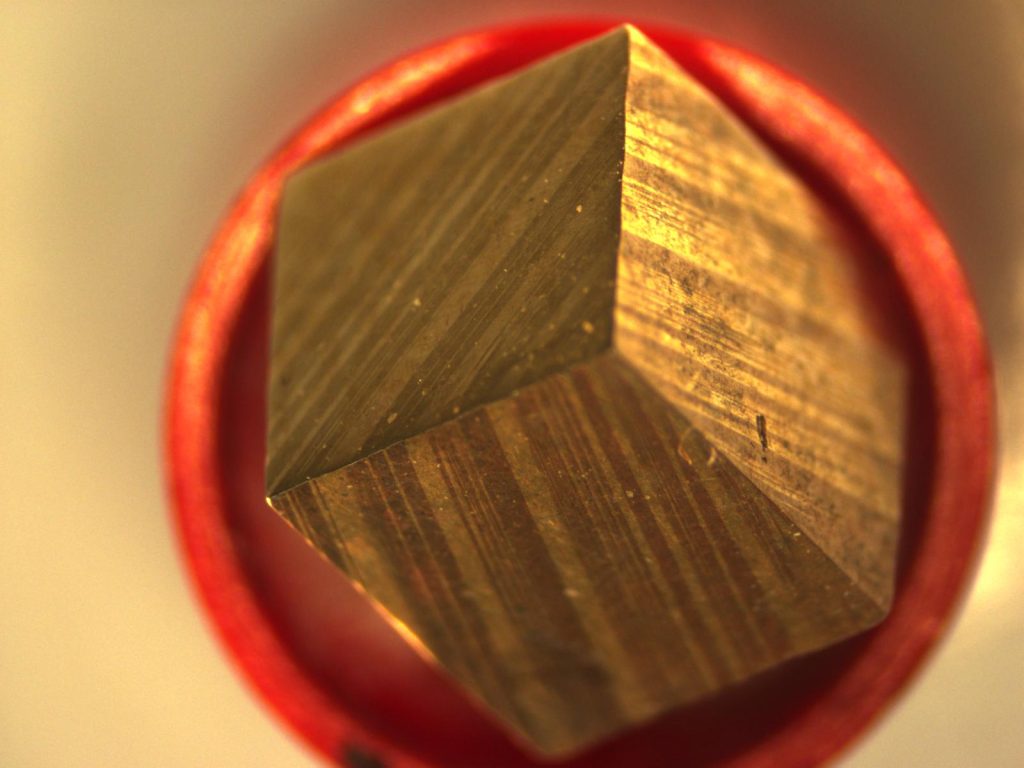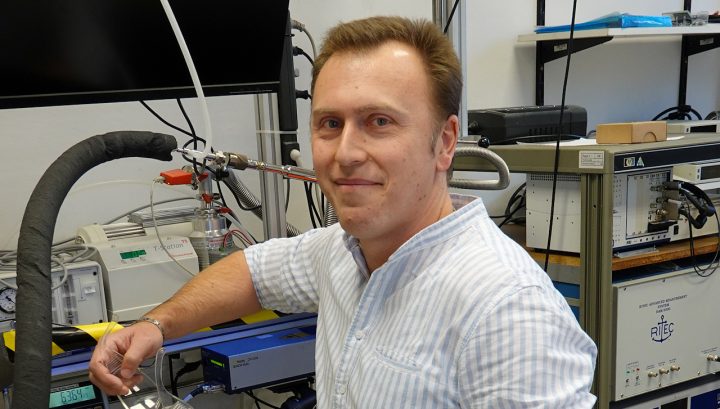In the years 2024-2028, the Institute of Thermomechanics of the CAS will be at the forefront of a scientific project called “Ferroic Multifunctionalities” (FerrMion). In the call of the Jan Amos Komenský Operational Programme (OP JAK) – Top Research, the Institute succeeded in a tough contest together with 4 other scientific institutions – the Institute of Physics of the CAS, the Institute of Nuclear Physics of the CAS, the Czech Technical University in Prague and Charles University.
The aim of the call was to support interdisciplinary research with a high potential to produce cutting-edge and future applicable research results, research based on an excellent research team and the development of international cooperation between research organisations. The Ministry of Education, Youth and Sports, which manages the OP JAK programme, expects the supported projects to contribute to increasing the involvement of Czech research organisations in international research, the production of more cutting-edge results and the development of the competitiveness of the Czech Republic.
We talked about this significant achievement of the Institute of Thermomechanics of the CAS and its partners with the principal investigator of the project, Professor Hanuš Seiner, Head of the Department of Ultrasonic Methods.
First of all, congratulations on your well-deserved success! The FerrMion project aims to describe the behaviour of ferroic materials using different scientific disciplines and to enable the use of their unique properties in industry. What are ferroic materials and what unique properties do they have?
I’ll answer in a roundabout way: most solid materials, both natural and engineering, have some internal microstructure that often determines macroscopic properties. Ferroics are unique in that their microstructure is to some extent mobile, and we can control it from the outside, flipping it between different orientations. For example, by magnetic fields, temperature changes, or mechanical loading. And the important thing is that ferroics respond instantly to such stimuli. They are therefore materials that can be dynamically controlled from the outside – as if they were simple machines or electromagnetic components.
The mobility of microstructures and the ability of ferroics to form mobile microstructures are linked to a number of other unique properties, be it mechanical instability, useful in biomedical applications, or the ability to extract heat from the environment, which could one day enable the design of very environmentally friendly cooling devices.

Cu-Al-Ni ferroelastic alloy crystal
Every field of science has its current challenges that scientists around the world are trying to overcome. What are the specific scientific goals of FerrMion?
There are more disciplines in the project. And together we ask the question: what actually prevents the transfer of laboratory knowledge about ferroic phenomena closer to applied research? Let’s say, for simplicity’s sake, that FerrMion aims to answer this question. But in fact, we have designed the project to tackle the actual challenges of each field on the way to that goal. Fellow metallurgists on the team will try to apply insights from ferroics physics to the development of new alloys for biomimetic joint replacements, while mathematicians will try to formulate equations describing heat transfer from ferroic components to flowing fluids, and in doing so find common ground with the refrigerant experts who are also on the team. There are technological challenges, such as preparing ferroic components by 3D printing or ion implantation, and theoretical challenges, such as how to capture the entanglement between different ferroic phenomena using computational quantum mechanical models.
The project will purchase a scientific instrument worth 150 million CZK, the so-called “3D atom probe tomography”. This device will be unique not only in the Czech Republic, but also in Central and Eastern Europe. What is the contribution of this instrument to the research of ferroic materials and what results do you expect from it?
Atom probe tomography is key to linking the physics of ferroics at the nanoscopic atomic level to the emergence of microstructures at spatial scales thousands of times longer. It will show us how homogeneously atoms of different chemical elements are distributed in ferroic crystals. It will enable theorists to know which atoms meet in the lattice of a crystal to give rise to ferroic phenomena, and material scientists to know in what large regions in the material such suitable “encounters” occur. It is a fascinating experimental method, still evolving and still opening new horizons. I think I speak for the whole FerrMion team when I say that we are hugely looking forward to working on such a device. Not only will it truly be the first facility of its kind in the former Eastern Bloc countries, but we also have the ambition to be the first to apply atom probe tomography to materials with moving microstructures, which in itself promises to be a great scientific adventure.
In which industrial applications will the project results be applied? Are there any promising applications for the Czech Republic?
There is no doubt that they exist. I have already mentioned biomedical engineering, where the Czech industry has a long tradition in the production of ferroelastic vascular reinforcements or joint replacements based on metastable titanium alloys. However, companies from many other sectors, from mechanical engineering to electrical engineering and the arms industry, have expressed interest in the research planned in the FerrMion project and have officially supported the project. The concept of active, externally controllable materials has always been attractive in principle for applications. But what we are saying is that we want to develop tools, meaning mathematical and computer models, technological processes and experimental protocols that can be used directly by developers from companies. And that, of course, generates even more interest. We’re not just talking about existing applications, on the contrary, we want to open up the space to discuss concepts that have not yet left the lab. For example, superelastic alloys for applications in flexible electronics, the use of ferroic nanoparticles in batteries, or so-called domain supercrystals, which can be changed from conductor to insulator and back again by modifying the ferroic microstructure. There are no limits to the imagination.
Such a large scientific project will undoubtedly contribute to the development of the the Department of Ultrasound Methods. How will the team develop?
I believe that not only our department team will develop, but the whole institute. Three departments are participating in the project, in addition to us, the Department of Thermodynamics, which will focus on the use of caloric effects such as ferroic cooling and ferroic heating, and the Department of Shocks and Waves in Solids, which will contribute its long experience in computer modelling of the mechanics of complex nonlinear systems. The project gives us the opportunity to open up new topics, recruit new people, internationalise our teams and in turn send our young staff to prestigious universities for internships abroad.
The Department of Ultrasound Methods will contribute what we do best. By analysing the instability of the crystal lattice in ferroics using ultrasonic waves and lasers, and the theoretical discussion of the associated mechanics of microstructures. By extending this approach with insights from atom probe tomography, our research can take on a whole new dimension and determine the direction of the whole project.
The Department of Ultrasound Methods has considerable experience and a track record of success in leading scientific projects involving several top-notch institutions. However, a budget of CZK 500 million for the entire project, almost half of which is for the Institute of Thermomechanics of the CAS, represents a move to a new level. How prepared is the Institute’s project team for this task?
The amount is truly awe-inspiring and very binding. I do not believe that there is a scientific team in the Czech Republic or even worldwide for which such a project would not be a challenge. I have great colleagues next to me in my team on whom I can always rely. We are prepared to the best of our ability – we have the determination, the desire to work and sufficient professional erudition. With the Institute’s management, with the other partners of the consortium and with the Ministry of Education, we have a common interest, namely that the amount contributes as much as possible to the development and functioning of Czech science. If none of us loses sight of this interest, everything will eventually succeed.
I would like to conclude with a personal question. Every scientist has dreams. What are yours and how will FerrMion help you to fulfill them?
Let me put it another way: every good scientist should be a dreamer, and I am. FerrMion now currently means that I and my team will have even a little less time to dream than before. We have a lot of work ahead of us with administration, expanding and managing the team, renovating labs, buying and installing instruments. That’s something no scientist dreams of. But once we get through this, the project gets going and meets its goals, we will hopefully be able to look back and see a good piece of scientific work behind us. That, I guess, is my dream.
Interview prepared by: P. Zima
Prof. Ing. Hanuš Seiner, Ph.D., DSc.
Hanuš Seiner was born in 1981 in Pardubice. He received his Ph.D. degree in 2008 at the Faculty of Nuclear and Physical Engineering of the Czech Technical University in Prague. In 2016, he received the Otto Wichterle Prize, which is awarded by the Czech Academy of Sciences to outstanding young scientists, and in 2021 he was awarded the degree of Doctor of Science (DSc.) in Theoretical and Applied Mechanics, which is awarded by the Czech Academy of Sciences to eminent personalities who have made a significant contribution to the development of their scientific field. In 2022, he received the title of Professor in Physical and Materials Engineering at the Czech Technical University in Prague.
During his scientific career, Hanuš Seiner has completed several international fellowships, e.g. at Oxford University in the UK, at the Leibniz Institute for Solid State Physics in Dresden, Germany, and at Tallinn University of Technology in Estonia. In 2017, he was awarded a Fulbright Scholarship and spent a one-year research fellowship at the University of Minnesota, USA.
His professional interests include the study of mechanical properties of solids, especially metallic materials, both experimentally using advanced methods employing principles of acoustics and laser optics, and theoretically by developing models of ferroic materials at the level of generalized continuum mechanics.

